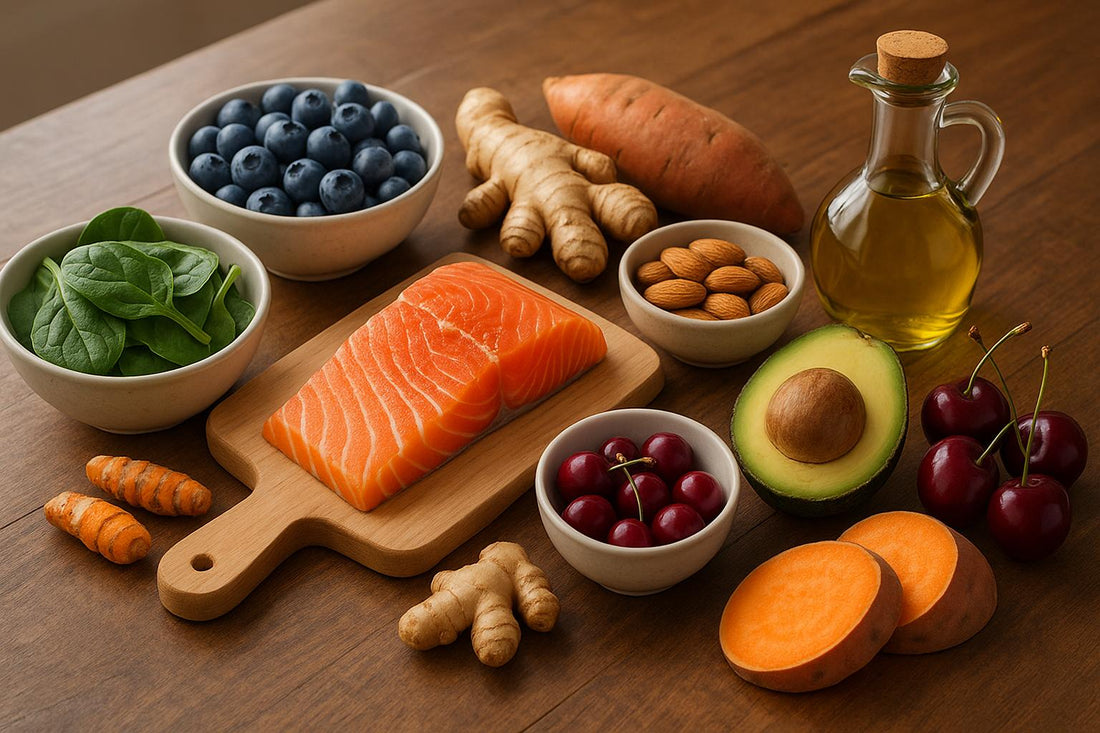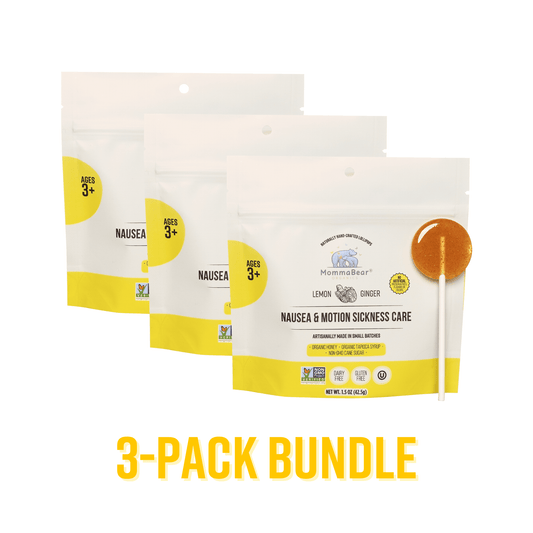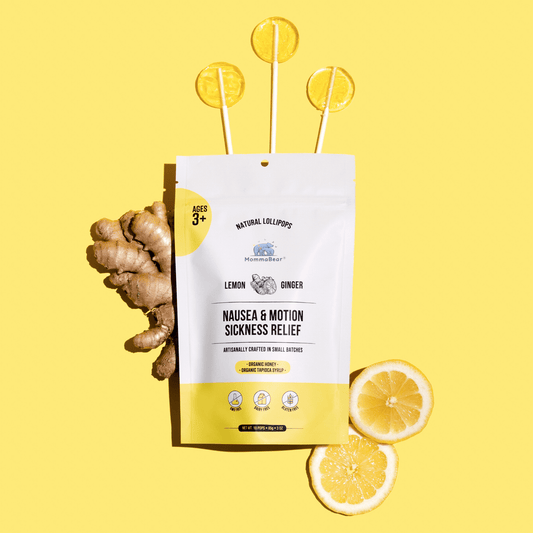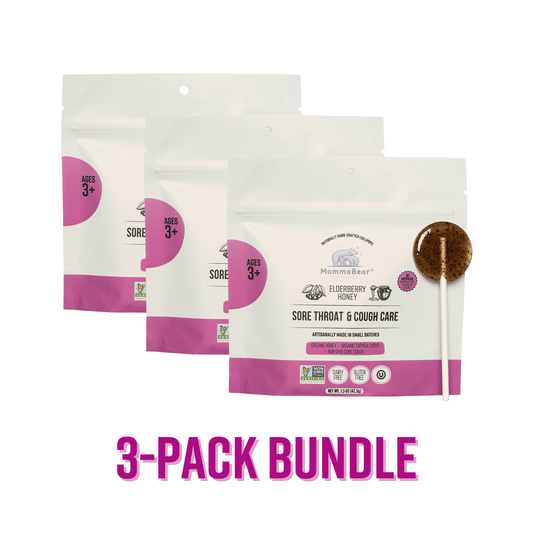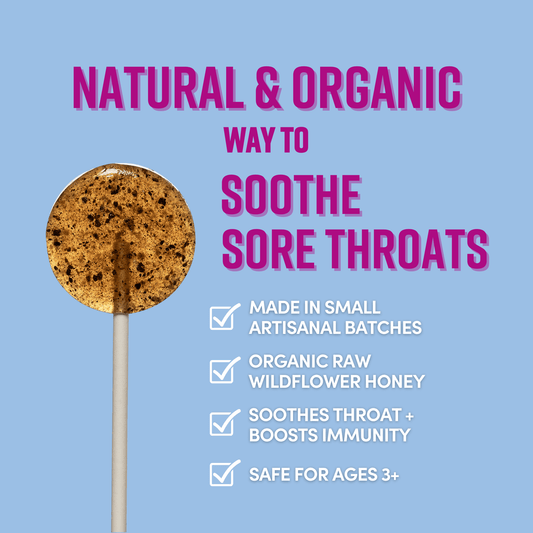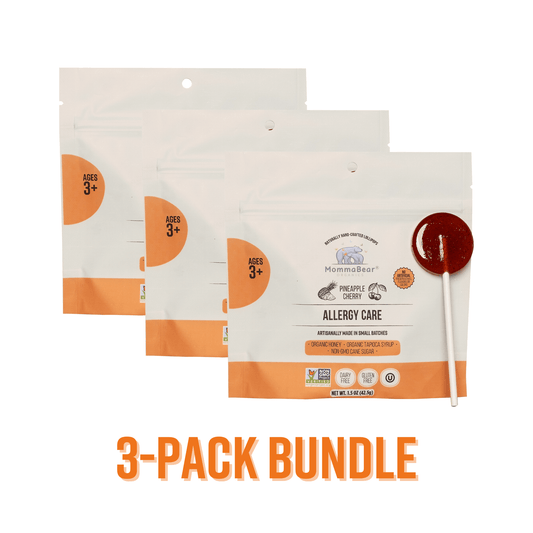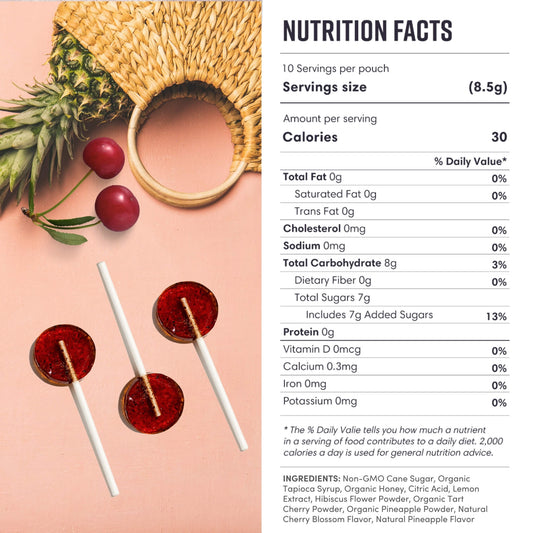Want to recover faster after workouts? These 10 anti-inflammatory foods can help reduce soreness, repair muscles, and get you back to training sooner. Here's what you need to know:
- Fatty Fish (Salmon, Mackerel): Packed with omega-3s to reduce inflammation and muscle damage.
- Turmeric (Curcumin): A natural anti-inflammatory that eases soreness and supports recovery.
- Leafy Greens (Kale, Spinach): Rich in antioxidants and nitrates to improve blood flow and repair muscles.
- Walnuts and Almonds: Provide omega-3s, vitamin E, and protein to combat inflammation and muscle pain.
- Berries (Blueberries, Tart Cherries): Loaded with antioxidants to reduce oxidative stress and speed up recovery.
- Ginger: Reduces muscle soreness and inflammation with its active compounds.
- Beets and Beetroot Juice: Boosts blood flow and lowers inflammation with nitrates and betalains.
- Extra Virgin Olive Oil: Acts like a natural ibuprofen with its anti-inflammatory polyphenols.
- Dark Chocolate (70%+ Cocoa): Improves blood flow and reduces inflammation with flavonoids.
- Pineapple (Bromelain): Eases pain and swelling with its anti-inflammatory enzyme.
Quick Comparison Table
| Food | Key Nutrients/Compounds | Benefits | Ease of Use |
|---|---|---|---|
| Fatty Fish | Omega-3s (EPA, DHA) | Reduces inflammation, muscle damage | Requires cooking |
| Turmeric | Curcumin | Eases soreness, boosts recovery | Pair with black pepper |
| Leafy Greens | Nitrates, antioxidants | Improves blood flow, repairs muscles | Easy to add to meals |
| Walnuts and Almonds | Omega-3s, Vitamin E | Fights inflammation, muscle pain | Ready-to-eat |
| Berries | Anthocyanins, polyphenols | Reduces oxidative stress | Versatile, fresh or frozen |
| Ginger | Gingerols, shogaols | Cuts soreness, speeds recovery | Fresh or powdered |
| Beets | Nitrates, betalains | Enhances blood flow, lowers swelling | Juice or cooked |
| Extra Virgin Olive Oil | Oleocanthal, polyphenols | Acts like ibuprofen | Drizzle on meals |
| Dark Chocolate | Flavonoids, magnesium | Improves blood flow, reduces soreness | Snack or dessert |
| Pineapple | Bromelain, Vitamin C | Eases pain, reduces swelling | Fresh or juiced |
Takeaway: Incorporate these foods into your diet to recover faster, reduce soreness, and support overall muscle health. Start simple - add berries to your breakfast, snack on nuts, or drizzle olive oil on your meals.
Top 6 Anti-Inflammatory Post-Workout Foods for Athletes | Switch4Good

1. Fatty Fish (Salmon, Mackerel)
Fatty fish like salmon, mackerel, sardines, and anchovies are known for their ability to combat inflammation and aid in muscle recovery. Packed with omega-3 fatty acids, these fish offer nutrients that are particularly helpful after rigorous exercise.
Anti-inflammatory Power
Fatty fish are loaded with EPA and DHA - types of omega-3 fatty acids that play a key role in reducing inflammation. For instance, 100 grams of raw pink salmon contains 419 mg of EPA and 586 mg of DHA. Since our bodies can't produce these essential fats, we need to get them from food. These omega-3s work by converting into compounds like resolvins and protectins, which help curb inflammation. They also lower the production of inflammatory molecules and inhibit the NF-κB pathway, which reduces levels of tumor necrosis factor-α (TNF-α), a marker of inflammation. This process directly supports faster recovery after workouts.
Supporting Muscle Recovery
Omega-3 fatty acids also shine when it comes to muscle recovery. Studies have shown that taking omega-3 supplements can noticeably reduce markers of muscle damage caused by exercise. For example, research found that delayed onset muscle soreness (DOMS) was less pronounced 72 to 96 hours after exercise when omega-3s were included in the diet. One specific study highlighted the benefits of a 6-gram fish oil dose (containing 4,200 mg of EPA and DHA), which helped reduce soreness and muscle damage.
Simple Ways to Add Fatty Fish to Your Meals
Adding fatty fish to your diet is easier than you might think. A 3.5-ounce serving delivers 20–25 grams of protein, making it a great post-workout meal. You can mix salmon into scrambled eggs, spread mashed sardines with lemon and mustard on sourdough, or pair fried salmon fillets with steamed vegetables. Rotating between options like salmon, mackerel, sardines, and herring keeps your meals varied and flavorful.
Backed by Science
The benefits of fatty fish are well-supported by research. The American Heart Association recommends eating at least two servings of fatty fish per week or taking 1.1–1.6 grams of omega-3 fish oil daily. For athletes, starting with around 1.5 grams of fish oil per day is a good baseline, but more advanced athletes might benefit from up to 3 grams daily. Regular consumption of fatty fish also provides broader health perks, such as a reduced risk of cardiovascular disease. Eating two to three servings of fish weekly can lower heart disease risk by 8–10%, while daily fish intake might reduce it by as much as 30%.
2. Turmeric (Curcumin)
Turmeric, the golden spice that gives curry its rich color, offers a natural, plant-based way to tackle post-workout inflammation. At the heart of turmeric’s benefits is curcumin, a compound that has been widely studied for its ability to ease exercise-induced inflammation and support muscle recovery.
Anti-inflammatory Properties
Curcumin works by targeting key inflammation pathways like NF-κB and COX-2, while also reducing cytokine production and free radical activity. On top of that, it enhances the body’s antioxidant defenses, which helps further reduce inflammation. This combination of actions makes curcumin a powerful tool for aiding recovery after intense physical activity.
Benefits for Muscle Recovery
Taking curcumin before and after exercise can significantly reduce muscle soreness and inflammation, which in turn boosts performance. For instance, a 2016 study published in BBA Clinical reported that participants taking 400 mg of Longvida® curcumin daily experienced smaller increases in markers like creatine kinase (down 48%), TNF-α (down 25%), and IL-8 (down 21%) following muscle damage caused by exercise. Similarly, a 2023 study in Frontiers in Nutrition found that adolescent athletes who took 1.2 g of curcumin daily for 12 weeks experienced noticeable reductions in muscle fatigue and soreness. Another study even documented a 77% drop in leg soreness and a 106% reduction in whole-body soreness compared to a control group. Research involving elite male footballers also highlighted curcumin’s ability to reduce inflammation (measured by CRP) and ease post-match soreness.
Easy Ways to Add Turmeric to Your Diet
Adding turmeric to your meals is both simple and tasty. To maximize curcumin absorption, pair turmeric with black pepper and healthy fats. You can mix it into milk, smoothies, scrambled eggs, or roasted vegetables. Studies show that combining curcumin with piperine (found in black pepper) can amplify its absorption by as much as 2,000%.
Backed by Science
Research consistently shows that curcumin supplements, in doses ranging from 90 to 5,000 mg per day, can ease muscle pain, enhance antioxidant capacity, and lower creatine kinase levels. Even at doses as high as 8,000 mg per day, curcumin is well tolerated, though its bioavailability remains a challenge.
"Anyone who's trying to manage inflammation could benefit from adding some turmeric to their foods."
– Mary-Eve Brown, Oncology Clinical Dietitian/Nutritionist, Johns Hopkins Medicine
Interestingly, curcumin works in a way that’s similar to NSAIDs, though it suppresses inflammation less aggressively. Some studies even suggest that turmeric can match ibuprofen in reducing inflammation, swelling, and pain. By lowering COX-2 expression and reducing prostaglandin release, curcumin helps alleviate muscle soreness. Altogether, the growing evidence highlights curcumin’s potential as a natural recovery aid for active individuals.
3. Leafy Greens (Kale, Spinach)
Leafy greens like kale and spinach pack a punch when it comes to reducing inflammation and aiding muscle recovery. These nutrient-rich vegetables are loaded with compounds that help your body bounce back after tough workouts.
Anti-inflammatory Compounds
Kale and spinach each bring unique inflammation-fighting benefits to the table. Kale is rich in flavonoids, especially kaempferol, which supports immune regulation and helps reduce inflammation. Some studies even suggest kaempferol may have anti-carcinogenic properties. Spinach, on the other hand, is a powerhouse of dietary nitrates. These nitrates can improve blood flow, lower blood pressure, and provide antioxidants that protect your cells from oxidative damage [29, 30]. Together, these greens not only combat inflammation but also create the ideal environment for your muscles to repair and recover.
Muscle Recovery Benefits
The anti-inflammatory properties of kale and spinach play a key role in muscle recovery. For example, one study found that runners who consumed spinach (1 gram per kilogram of body weight daily for two weeks) experienced less oxidative stress and muscle damage after a half-marathon. This was evident from lower creatine kinase levels the day after the race. Additionally, research shows that a high-nitrate diet - about 90 mg of nitrates daily from leafy greens - can enhance leg strength and walking speed. With just one cup of leafy greens providing around 75 mg of nitrates, it's easy to meet these beneficial levels. Nitrates also improve blood flow and nutrient delivery to muscles, speeding up recovery. Plus, the vitamin K in these greens supports bone health, adding to their recovery-boosting benefits.
Easy Ways to Add Them to Your Diet
Adding kale and spinach to your meals is a breeze. Toss them into smoothies, mix them into salads, or use them in wraps for a quick nutrient boost. They also work well in soups, stews, or sautéed with garlic and olive oil for a simple yet flavorful dish [37, 39]. These greens are incredibly versatile, making it easy to include them in your day-to-day meals.
Backed by Science
Research further highlights the benefits of these greens. Drinking kale juice, for instance, has been shown to improve cholesterol levels and enhance antioxidant activity. Kate Patton, MEd, RD, CSSD, LD, a preventive cardiology dietitian, emphasizes their importance:
"Leafy greens are so good for you that you really can't eat too many. In fact, they're considered heart-healthy superfoods."
The science is clear: kale and spinach each offer unique advantages for recovery and overall health. To get the most out of these greens, try cooking them to deactivate enzymes that might interfere with thyroid function. Up next, we’ll see how nuts can complement these greens in reducing inflammation and enhancing recovery.
4. Walnuts and Almonds
Nuts are a powerhouse when it comes to fighting inflammation and helping muscles recover after a tough workout. Among them, walnuts and almonds stand out for their unique combination of nutrients that can support your body as it bounces back.
Anti-inflammatory Properties
Almonds are packed with vitamin E, polyphenols, copper, and zinc - all of which help shield your cells and boost antioxidant enzymes. On the other hand, walnuts bring omega-3 fatty acids and prebiotics to the table, which can further reduce inflammation and promote gut health. For example, just 1 oz (28 g) of almonds delivers 7.27 mg of vitamin E - half of your daily recommended intake. This powerful antioxidant helps protect cell membranes by neutralizing harmful lipid peroxides. Additionally, the copper and zinc in almonds are crucial for the activity of superoxide dismutase (SOD), a key enzyme that combats oxidative stress.
Muscle Recovery Support
Adding almonds to your diet can significantly improve muscle recovery. A study in Current Developments in Nutrition found that adults who ate 2 oz of almonds daily for eight weeks had better recovery after a 30-minute downhill treadmill workout. Participants reported 37% less muscle pain after 24 hours and 33% less after 48 hours. Physical tasks felt easier, with muscle soreness reduced by around 24%. Even better, creatine kinase levels - a marker of muscle damage - dropped by 50% after 72 hours, compared to just a 33% reduction in the control group.
Dr. Mark Kern, PhD, RD, CSSD, a professor at San Diego State University, highlights the benefits of almonds:
"Almonds contain a wide range of nutrients that we know support exercise recovery including protein, antioxidants and phytonutrients. These nutrients are supplied in a whole food package versus isolated vitamin supplements which may contribute to the almond benefits observed in this study."
Easy Ways to Add Them to Your Diet
Incorporating walnuts and almonds into your meals is effortless. Sprinkle chopped walnuts over your oatmeal or cereal to start your day, or mix almonds into a trail mix with dried fruits for a quick post-workout snack. They’re also great in salads, adding a satisfying crunch, or stirred into chicken or tuna salad for wraps and sandwiches. Want something different? Blend walnuts with basil and olive oil for a quick pesto, or toast them to top off your yogurt or ice cream. These nuts are incredibly versatile and pair well with other recovery-friendly foods.
Backed by Science
Almonds pack a nutritional punch with 6 g of protein, 4 g of fiber, 77 mg of magnesium (18.3% DV), and 210 mg of potassium (4% DV). They also provide essential and nonessential amino acids, including branched-chain amino acids (BCAAs), which help reduce soreness and maintain muscle function. Lalitha McSorley, a physical therapist at Brentwood Physiotherapy Calgary, emphasizes:
"Almonds are a nutrient-rich snack that can help athletes reach their peak performance, as they provide the body with protein, healthy fats, and key vitamins and minerals. They are high in vitamin E, which helps protect cells from oxidative damage caused by exercise."
Together, walnuts and almonds are a powerful duo for reducing inflammation and speeding up muscle recovery, making them a smart addition to any post-workout routine.
5. Berries (Blueberries, Tart Cherries)
When it comes to muscle recovery, berries like blueberries and tart cherries pack a punch. Loaded with antioxidants and compounds that fight inflammation, they help reduce soreness and speed up recovery after tough workouts.
Anti-inflammatory Powerhouses
Blueberries and tart cherries owe their recovery benefits to compounds like anthocyanins and polyphenols, which combat oxidative stress. Tart cherries, in particular, stand out with 20 times more vitamin A than their sweet counterparts and up to five times the antioxidant levels. These nutrients, along with proanthocyanins and flavonols, work together to ease inflammation and support quicker recovery.
Muscle Recovery in Action
The antioxidants in these berries help repair muscles by reducing oxidative damage. Research highlights their effectiveness: blueberries can improve recovery within the first 36 hours after intense training by minimizing cellular damage. Tart cherries are equally impressive. A study from London South Bank University found that athletes who consumed 1 ounce of tart cherry juice concentrate twice daily for seven days before and two days after strength training regained 90% of their muscle strength within 24 hours. Additionally, marathon runners who drank 16 oz (480 mL) of tart cherry juice in the days surrounding their race reported three times less pain and reduced muscle damage and inflammation compared to those who didn’t.
Easy Ways to Add Them to Your Diet
Adding these berries to your meals is a breeze. Sprinkle a handful of blueberries over your oatmeal or yogurt, blend them into a smoothie, or toss them into a salad for a burst of flavor. Tart cherries are just as versatile - drink them as juice, mix dried cherries into trail mix, or layer them in a parfait with Greek yogurt and granola.
Registered Dietitian Chelsea LeBlanc Jones suggests a post-workout smoothie with frozen blueberries, Greek yogurt, oats, honey, vanilla, and cinnamon for a tasty recovery boost.
Backed by Science
The benefits of blueberries and tart cherries are well-supported by research. A 2018 study showed that blueberries not only enhanced exercise performance but also reduced inflammation markers, aiding recovery. Associate Professor Steve Stannard from Massey School of Sport and Exercise confirmed that blueberries speed up muscle recovery during the critical first 36 hours after training. For tart cherries, studies show they help restore muscle strength faster and lower inflammation markers like C-reactive protein (CRP). To maximize the benefits, choose unsweetened tart cherry products to avoid added sugars that could negate their positive effects.
Whether fresh, frozen, dried, or juiced, blueberries and tart cherries are a flavorful, research-backed way to support muscle recovery and overall health.
6. Ginger (Fresh or Powdered)
Ginger is well-known for its ability to support muscle recovery, thanks to its active compounds - gingerols, shogaols, and 6-Shogaol. These compounds work by reducing inflammation through mechanisms like blocking COX1/2 enzymes, inhibiting cytokine production, and interfering with arachidonic acid metabolism, which decreases the production of prostaglandins and leukotrienes.
Muscle Recovery Benefits
Research shows that ginger can cut down delayed onset muscle soreness (DOMS) by about 25% within 24 hours after exercise. Regular consumption - about 2 grams daily over 5 to 11 days - has been shown to speed up muscle strength recovery. For instance, in one study, 20 participants who weren’t accustomed to weight training took ginger for five days before intense exercise. The results? Faster recovery of muscle strength. Similarly, college athletes who consumed 2.2 grams of ginger root daily for five days reported feeling less sore after long training sessions. This makes ginger an effective and practical choice for improving recovery.
Easy Ways to Add Ginger to Your Diet
Incorporating ginger into your meals or snacks is simple. You can add it to teas, soups, smoothies, or stir-fries. Fresh ginger tends to pack more flavor and contains higher levels of antioxidants compared to powdered forms. A daily intake of 2–4 grams of raw ginger can provide anti-inflammatory and antioxidant benefits. For example, start your morning with a cup of ginger tea made with fresh slices, or mix ginger into marinades for a flavorful boost. It’s also great in juices, or you can try turmeric and ginger shots or lemon ginger tea for a concentrated dose.
Backed by Science
Clinical studies highlight ginger’s ability to reduce muscle soreness by 25%, offering a natural alternative to NSAIDs but with fewer side effects. Interestingly, a 4-gram dose taken over five days has been shown to speed up strength recovery more effectively than a 2-gram dose. In a randomized, double-blind, placebo-controlled study involving 32 runners, five days of ginger supplementation significantly reduced soreness and DOMS after running. Exercise physiologist James Smoliga noted:
"Accelerated recovery in muscle strength could be useful for athletes competing in events where multiple bouts of maximal exercise must be performed in a short period of time (e.g. a qualifying round of competition preceding a final round by 48 h)."
Beyond easing muscle pain, ginger might also help with glycogen storage in skeletal muscles and improve exercise performance by enhancing fat oxidation. While these findings are mainly based on animal studies, human research consistently points to ginger’s ability to support healthy inflammatory responses and manage pain effectively.
sbb-itb-e1a023f
7. Beets and Beetroot Juice
Much like ginger, which helps reduce inflammation by inhibiting certain enzymes, beets offer recovery benefits thanks to their unique compounds like betalains and nitrates. These natural elements in beets play a significant role in reducing inflammation and aiding recovery.
Anti-inflammatory Compounds
The recovery power of beets is rooted in their betalains - nitrogen-based pigments that come in two types: betacyanins (red pigments) and betaxanthins (yellow pigments). These compounds actively block inflammation signals in the body by interfering with pro-inflammatory pathways, including the Nuclear Factor-Kappa B (NF-κB) cascade, a key driver of inflammation.
Specific betalains like betanin and betanidin are particularly effective, suppressing COX-2 expression by up to 97% and reducing LOX activity to just 9% of normal levels. This means they significantly dampen the body’s inflammatory response.
Beyond betalains, beetroot juice is packed with nitrates, flavonoids, and phenolic compounds, all of which contribute to its recovery benefits. These components work together to not only combat inflammation at a molecular level but also provide practical recovery advantages.
Muscle Recovery Benefits
Beetroot has been shown to speed up recovery and reduce muscle soreness after intense physical activity. A review of nine studies highlighted that short-term beetroot supplementation can accelerate functional recovery and ease muscle soreness.
Research also indicates that beetroot supplementation helps moderate inflammatory biomarkers, further supporting its role in recovery. Interestingly, beetroot juice outperformed nitrated beverages in reducing muscle pain, suggesting that its benefits extend beyond just nitrates to include other phytonutrients.
Easy Ways to Add Beets to Your Diet
Beets aren’t just effective - they’re also easy to include in your meals. To maximize recovery, drink 7–10 oz of beet juice right after exercising or, for a pre-workout boost, consume two cups of beet juice (or two to three whole beets) 2–3 hours before your session.
If the earthy flavor of beet juice isn’t your favorite, try blending it into a smoothie with berries, bananas, or citrus fruits for a more balanced taste. Another simple option is beet powder, which you can mix into a shaker cup or even a collagen latte. Pre-cooked, sliced beets are also a great addition to salads or pre-workout meals.
For those with busy schedules, beet energy chews offer a portable solution. Brands like Love Beets make it even easier by offering roasted, marinated, and pickled beets, along with ready-to-drink beetroot juice. Jerry Bailey, D.C., LA.c., a certified nutritionist and functional medicine practitioner, explains:
"By increasing blood flow, you increase nutrient and oxygen delivery to the muscles and the removal of waste."
Scientific Evidence Backing Beetroot Benefits
The benefits of beetroot go beyond just muscle recovery. A 2024 study found that beetroot juice positively influenced inflammatory markers in adults dealing with long COVID. Additionally, in osteoarthritic patients, betalain-rich capsules derived from beetroot extracts helped alleviate inflammation and pain.
For optimal results, experts suggest starting beetroot supplementation a few days before exercise and continuing for at least 72 hours afterward - a total of 5 to 6 days. As researchers emphasize:
"The existing evidence suggests that a short-term beetroot supplementation has the potential to accelerate recovery of functional measures and muscle soreness, but further research is needed to clarify if a longer supplementation period (with some days before exercise and some days after) could also promote recovery of markers of muscle damage, inflammation, and oxidative stress."
Female athletes, in particular, may find beetroot supplements especially helpful. Researchers note:
"Female volleyball players may use BRJ supplements after matches or high-pressure training for improved recovery of muscle endurance and pain reduction."
8. Extra Virgin Olive Oil
When it comes to muscle recovery, extra virgin olive oil (EVOO) stands out for its natural anti-inflammatory properties. Unlike processed oils, EVOO is packed with compounds that act similarly to ibuprofen, helping to ease post-workout inflammation and aid muscle repair.
Anti-inflammatory Compounds
The secret to EVOO's recovery benefits lies in its unique combination of monounsaturated fats and bioactive compounds. Oleic acid, which makes up 55-83% of its fatty acid content, plays a key role in promoting heart health and reducing inflammation.
EVOO also contains powerful polyphenols like oleocanthal and hydroxytyrosol. Oleocanthal works by inhibiting COX enzymes, mimicking the action of ibuprofen, while hydroxytyrosol neutralizes free radicals. Together with oleic acid and vitamin E, these compounds help lower pro-inflammatory cytokines such as interleukin-6 (IL-6) and tumor necrosis factor-alpha (TNF-α), which are often elevated after intense exercise.
Muscle Recovery Benefits
Research has shown that EVOO can speed up recovery. A 2025 study published in the Journal of Physical Education and Sport highlighted the role of EVOO as a functional food for athletes. The study found that its polyphenols reduce post-exercise oxidative stress and inflammation.
The same research revealed that hydroxytyrosol and other olive-derived compounds enhance endurance, activate mitochondria, and improve recovery in both animal and human studies. These results translate into quicker recovery times and less muscle soreness after demanding workouts.
"Athletes are known to experience inflammation due to the intensity of their exercise. The anti-inflammatory properties of EVOO could potentially assist in quicker recovery post-exercise, as well as minimizing muscle soreness." - Sian Armstrong, Olive Wellness Institute
Experts recommend consuming 2-3 tablespoons of EVOO daily to harness its recovery benefits. It's a simple, science-backed addition to your diet that supports both performance and recovery.
Easy Ways to Add EVOO to Your Diet
One of the best things about EVOO is how effortlessly it fits into everyday meals. Unlike some recovery foods that need special preparation, EVOO is versatile and can be used in a variety of dishes, from breakfast to dinner.
- Swap butter for EVOO: Use about ¾ the amount of olive oil as butter in recipes.
- Make simple salad dressings: Mix 3 parts EVOO with 1 part vinegar or lemon juice, and add herbs for flavor.
- Drizzle over finished dishes: Add a splash of EVOO to soups, grilled meats, roasted vegetables, or scrambled eggs for a quick anti-inflammatory boost.
"Extra virgin olive oil is extremely versatile and can be used for both high-temperature cooking and finishing meals. With so many ways to use it, consuming the recommended 2-3 tablespoons daily doesn't have to be difficult!" - Sian Armstrong
Backed by Science
Studies consistently show that EVOO is a powerful tool for reducing inflammation. Those following a Mediterranean diet enriched with EVOO have been found to have lower levels of inflammatory markers compared to individuals on low-fat diets. Additionally, research indicates that olive oil polyphenols can suppress inflammatory gene expression in immune cells, offering protection at the cellular level.
"Extra virgin olive oil can reduce inflammation, which may be one of the main reasons for its health benefits. Olive oil's main anti-inflammatory effects are from antioxidants, one of which is oleocanthal. This antioxidant has been shown to work like ibuprofen, an anti-inflammatory drug." - Katherine D. McManus, MS, RD, LDN
9. Dark Chocolate (70%+ Cocoa)
Dark chocolate with at least 70% cocoa delivers more than just a rich flavor - it packs a punch when it comes to aiding muscle recovery after challenging workouts. Unlike its milk or white counterparts, high-cocoa dark chocolate is loaded with compounds that help reduce inflammation and repair tissues.
Anti-inflammatory Powerhouses
Dark chocolate is a treasure trove of polyphenols, including flavanols like (–)-epicatechin, (+)-catechin, and proanthocyanidins. These act as antioxidants, working to reduce inflammation by influencing critical signaling pathways. For instance, cocoa flavanols can decrease the activation of inflammatory transcription factors, which tend to spike after intense physical activity.
How It Supports Muscle Recovery
One standout compound in dark chocolate, (–)-epicatechin, has been shown to enhance nitric oxide production. This process improves blood flow to muscles, boosts endurance, and helps delay fatigue during exercise. A study on female CrossFit athletes revealed that consuming 85% dark chocolate enhanced performance in high-intensity workouts, especially during the premenstrual phase. Similarly, elite football players who ate 40 grams of 85% dark chocolate daily for a month experienced increased antioxidant activity, reduced inflammation, and lower muscle damage markers like creatine kinase (CK) and lactate dehydrogenase (LDH).
Simple Ways to Add It to Your Diet
Adding dark chocolate to your daily meals or snacks is both easy and effective. A practical approach is to enjoy about 40 grams per day, split into two 20-gram servings. Have one in the morning and the other before bed to keep the beneficial polyphenols working for you. Eating dark chocolate roughly two hours before a workout can provide an energy boost and improve blood flow, while a post-workout serving helps restore glycogen levels and supports muscle repair.
"Since running causes acute inflammation in the muscles and joints, eating chocolate before or after a workout may help reduce the inflammation." – Natalie Rizzo, R.D.
For an extra recovery boost, pair dark chocolate with protein-rich foods like Greek yogurt, nut butter, milk, or almonds. This combination delivers both antioxidants and the amino acids your muscles need to rebuild, making dark chocolate a versatile and delicious addition to your recovery plan.
Backed by Science
The research is clear: dark chocolate is a powerful ally for muscle recovery. Opting for chocolate with at least 70% cocoa ensures a high dose of polyphenols, which have been shown to enhance blood flow to the brain, support cognitive function, and improve cardiovascular and metabolic performance during exercise. It also provides essential minerals like magnesium, potassium, and iron, along with healthy fats that further aid recovery. With its proven benefits, dark chocolate is an easy and science-supported way to elevate your post-workout nutrition.
10. Pineapple (Bromelain)
Pineapple is more than just a tropical treat - it plays a role in muscle recovery thanks to bromelain, a special enzyme found in its flesh and stem. For centuries, people in South and Central America have used bromelain for its healing properties. Let’s dive into how this natural compound supports recovery.
Anti-inflammatory Properties
The key player in pineapple is bromelain, an enzyme known for its ability to break down proteins and its medicinal benefits. As Zumpano explains:
"Bromelain, an enzyme that promotes the healing of your skin and tissues, is only found in pineapples. It seems that bromelain produces compounds that fight inflammation and pain."
Alongside bromelain, pineapple is packed with vitamin C and manganese, which boost antioxidant defenses - all this in just 75 calories per cup.
How It Helps Muscle Recovery
Bromelain works by reducing the production of inflammatory cytokines, which helps ease pain and swelling after tough workouts. Its anti-inflammatory and pain-relieving effects can alleviate post-exercise muscle soreness, swelling, and joint stiffness.
Research suggests eating at least 1.5 cups of pineapple post-workout can help minimize muscle damage and speed up recovery. The vitamin C in pineapple also supports tissue repair, while bromelain may reduce post-exercise fatigue.
Easy Ways to Add Pineapple to Your Diet
Pineapple isn’t just effective - it’s also incredibly versatile. One cup of fresh pineapple chunks or 8 ounces of pineapple juice provides enough bromelain to support recovery. Whether fresh, canned, or juiced (without added sugar), pineapple retains its nutritional benefits.
To maximize its impact, enjoy pineapple shortly after your workout. Blend it into a smoothie, toss chunks into Greek yogurt, or try this simple recovery treat: blend 2 frozen bananas, 1/3 cup frozen pineapple chunks, 1/3 cup Greek yogurt, and 1 tablespoon of cinnamon for a creamy, protein-packed "ice cream".
If fresh pineapple causes a tingling or mild burning sensation - due to bromelain’s protein-digesting action - pair it with dairy to neutralize the effect.
What Science Says
Research shows that consuming up to 12 grams of bromelain daily is safe. For therapeutic purposes, typical doses range from 80 to 400 milligrams per serving, taken two to three times a day. Bromelain is most effective for reducing inflammation when taken on an empty stomach, as this allows it to focus on inflammation rather than digesting food proteins.
The long-standing use of bromelain in Central and South America, combined with modern research on its ability to lower inflammation, highlights pineapple’s value in a recovery-focused diet. As a natural, tasty option to ease post-exercise inflammation, pineapple offers a flavorful alternative to synthetic remedies.
Food Comparison Chart
When it comes to selecting anti-inflammatory foods to aid muscle recovery, understanding each food's unique benefits can help you create a well-rounded recovery diet. From omega‑3 content to antioxidant levels, each option brings something valuable to the table. Here's a quick summary of their standout qualities.
Omega‑3 Heavyweights: Fish vs. Nuts
Fatty fish like salmon and mackerel are rich in EPA and DHA, two types of omega‑3 fatty acids that are highly beneficial for overall health. On the other hand, walnuts offer a plant-based option, providing an impressive 1,884 mg of ALA per ounce (roughly 10 walnuts). Just one handful of walnuts meets the daily ALA requirement, which is linked to a 10% lower risk of all-cause mortality when consuming around 1.6 grams of ALA daily compared to less than 0.8 grams.
| Food Category | Anti-Inflammatory Compounds | Key Nutrients | Convenience |
|---|---|---|---|
| Fatty Fish | EPA & DHA omega‑3s | Protein, vitamin D | Requires cooking; aim for 4 oz |
| Walnuts | 1,884 mg ALA per oz | Healthy fats, protein | Ready-to-eat; a handful meets needs |
| Almonds | Vitamin E, magnesium | Protein, fiber | Ready-to-eat |
| Berries | Anthocyanins, flavonoids | Vitamin C, fiber | Fresh or frozen; versatile in meals |
| Dark Chocolate | Flavonoids, polyphenols | Magnesium, iron | Ready-to-eat; 70%+ cocoa recommended |
| Turmeric | Curcumin | Manganese, iron | Needs prep; pairs with black pepper |
This chart highlights how each food contributes to a balanced recovery plan, offering a variety of nutrients and anti-inflammatory properties.
Antioxidant Powerhouses: Berries vs. Dark Chocolate
When comparing antioxidants, berries and dark chocolate stand out. Berries average 9.86 mmol of antioxidants per 100 grams, while chocolates and sweets average 4.93 mmol per 100 grams. However, dark chocolate with 70–99% cocoa content jumps to 10.9 mmol per 100 grams, nearly rivaling berries. Among berries, blackberries surpass blueberries in anthocyanin content, while pomegranates outperform blueberries in overall antioxidant effects. Goji berries, for their part, deliver over five times the vitamin C found in blueberries.
Convenience Counts
Ease of use can make or break your food choices. Nuts and berries are perfect for quick, no-prep snacking, while dark chocolate provides an instant antioxidant boost. Spices like turmeric and ginger pack a punch but require some preparation - turmeric, for example, is most effective when paired with black pepper to increase absorption. Fatty fish, while requiring cooking, offers unparalleled omega‑3 benefits. Aim for a 4-ounce serving of salmon or tuna post-workout.
As registered dietitian Kimberly Collins explains:
"When we work out, lifting weights or otherwise, we tear muscles to build muscles. Knowing this, we can focus on eating foods that help our bodies build muscle."
In short, balance convenience with nutrient density. Walnuts are a top-notch source of omega‑3s, dark chocolate (with at least 70% cocoa) delivers potent antioxidants, and fatty fish provides bioavailable omega‑3s. Your choice will depend on your lifestyle, taste preferences, and recovery goals.
Conclusion
Incorporating anti-inflammatory foods into your post-workout routine can significantly improve how quickly your body bounces back after exercise. These foods work by addressing inflammation at its root, helping to reduce muscle soreness and accelerate muscle repair. Whether you're grappling with delayed onset muscle soreness or simply want to feel better after a tough workout, these nutrient-rich options can help your body recover and ease discomfort.
Dr. Christopher Suhar, medical director of the Scripps Center for Integrative Medicine, highlights the importance of diet in managing inflammation:
"Your food choices are just as important as the medications and supplements you take for overall health since they can protect against inflammation."
Making small, deliberate changes is a great place to start. Try adding fatty fish like salmon to your meals twice a week, tossing some berries into your morning smoothie, or snacking on walnuts after a workout. Even simple swaps, like using extra virgin olive oil instead of refined oils, can make a difference.
For a balanced recovery meal, aim to fill half your plate with colorful vegetables, one quarter with whole grains, and the remaining quarter with lean protein, such as salmon or chicken. If you're pressed for time, quick options like chocolate milk, tart cherry juice, or a banana can provide a convenient recovery boost without the hassle of meal prep.
Whole, unprocessed foods not only enhance recovery but also promote overall health. Experiment with different combinations to find what fits your taste, schedule, and fitness goals. As Dr. Frank Hu from Harvard School of Public Health explains, a healthy diet doesn’t just reduce the risk of chronic diseases - it also improves mood and quality of life.
Consistency is the foundation of success. By regularly incorporating these anti-inflammatory foods, you’ll support your recovery efforts while setting the stage for long-term wellness. This approach not only aligns with your fitness goals but also nurtures your overall health.
FAQs
What are some easy ways to include anti-inflammatory foods in my diet to support muscle recovery?
Incorporating foods that help combat inflammation into your meals can be both easy and flavorful. Look for nutrient-rich choices like fatty fish (think salmon or mackerel) loaded with omega-3s, leafy greens (such as spinach and kale), berries (like blueberries and cherries), and nuts (including walnuts and almonds). These ingredients not only help reduce inflammation but also aid in quicker muscle recovery.
There are plenty of creative ways to bring these into your daily diet. Kick off your day with a smoothie blending spinach, berries, and almond milk, or toss together a salad featuring kale, walnuts, and a splash of olive oil. Small, steady tweaks like these can go a long way in boosting your recovery and overall well-being.
What are some effective food combinations to boost muscle recovery and reduce inflammation?
Combining certain foods known for their anti-inflammatory properties can boost their impact on muscle recovery. Take fatty fish like salmon, for instance. It's loaded with omega-3 fatty acids, which are great for reducing inflammation. Pair it with blueberries, a powerhouse of antioxidants, and you've got a duo that supports muscle repair and fights inflammation effectively.
Another smart pairing? Tart cherry juice with a protein-rich option like Greek yogurt. Together, they can help ease muscle soreness and potentially speed up recovery by complementing each other’s benefits.
For a nutrient-packed combo, try spinach and tomatoes. This pair not only delivers essential vitamins and minerals but also enhances nutrient absorption, giving your body an extra recovery boost. Adding these combinations to your meals can play a key role in helping your body recover after tough workouts.
How do anti-inflammatory foods compare to pain relievers like ibuprofen for muscle recovery?
Anti-inflammatory foods and medications like ibuprofen tackle inflammation in entirely different ways. Foods packed with antioxidants, omega-3 fatty acids, and essential nutrients - think salmon, berries, and spinach - work to naturally reduce inflammation over time. Regularly adding these foods to your meals can support ongoing muscle recovery and promote overall well-being.
On the other hand, ibuprofen offers quick, short-term relief for pain and inflammation. The effects of anti-inflammatory foods, however, take longer to kick in and depend on consistent consumption. While these foods won’t replace the immediate relief that medication provides, they can complement your recovery efforts and serve as a long-term strategy for managing inflammation.

